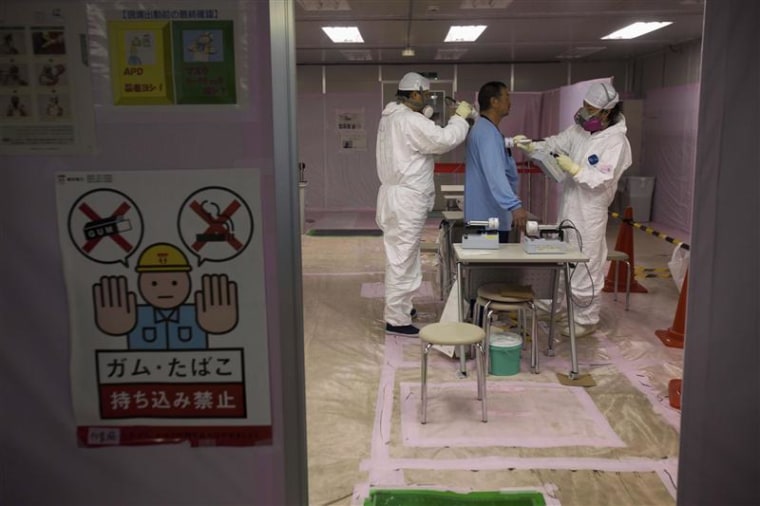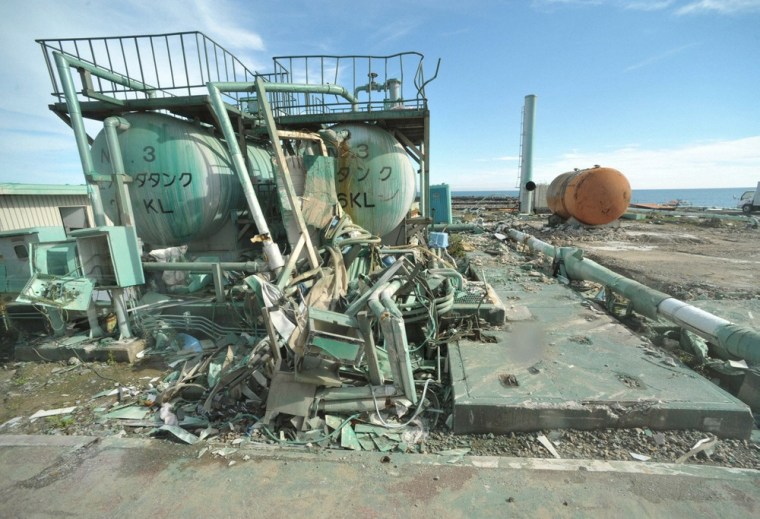Conditions at Japan's wrecked Fukushima nuclear power plant, devastated by a tsunami in March, were slowly improving to the point where a "cold shutdown" would be possible as planned, officials said on Saturday during a tour of the facility.
Officials shepherded a group of about 30 mainly Japanese journalists through the plant for the first time since the meltdown of the plant's reactors, the worst nuclear accident since Chernobyl 25 years ago.
Cooling systems at the plant, 240 km (150 miles) northeast of Tokyo, were knocked out by the powerful tsunami and evidence of the devastation was clear to see.
The nuclear reactor buildings were still surrounded by crumpled trucks, twisted metal fences, and large, dented water tanks. Smaller office buildings around the reactors were left as they were abandoned on March 11, when the tsunami hit.
Cranes filled the skyline in testimony to recovery efforts.
Journalists on the tour mainly stayed on a bus as they were driven around the plant and were not allowed near the reactor buildings. Still, they all had to wear protective suits, double layers of gloves and plastic boot covers and hair nets.
All carried respiration masks and radiation detectors.
"From the data at the plant that I have seen, there is no doubt that the reactors have been stabilized," Masao Yoshida, chief of the Daiichi plant, told the group.

The compound may still be littered with rubble, but Tokyo Electric Power (Tepco), the utility operating the plant, has succeeded in bringing down the temperatures at the three damaged reactors from levels considered dangerous.
They are confident they will be able to declare a "cold shutdown" -- when temperatures are stable below boiling point -- as scheduled by the end of this year.
While Tepco had managed to stabilize conditions so workers could enter the reactor buildings, Yoshida said there was still danger involved for those working there.
The disaster prompted the government to declare a 20-kilometer no-entry zone around the plant, forcing the evacuation of about 80,000 residents.
A cold shutdown is one of the conditions that must be met before the government considers lifting its entry ban.
As an emergency measure early in the crisis, Tepco tried to cool the damaged reactors by pumping in huge volumes of water, much of it from the sea, only to leave a vast amount of tainted runoff that threatened to leak out into the ocean.
It solved the problem by building a cooling system to clean the radioactive runoff, using some of the water to cool the reactors.
A group of white tents houses the cleaning facility. In front were hoisted the flags of the United States, France and Japan — the countries that provided the technology for the decontamination system.
"Every time I come back, I feel conditions have improved. This is due to your hard work ," Japan's environment and nuclear crisis minister Goshi Hosono told workers at the plant.
However, Hosono warned it would still take about 30 years to dismantle the reactors after a cold shutdown was achieved.
Workers engaged in the recovery effort are stationed at J-Village, a national soccer training center near Daiichi that has been converted into an operational base.
Tepco says up to 3,300 workers a day arrive from J-Village, located on the edge of the 20-kilometer no-entry zone.
At J-Village, workers on their way to the plant lined up at a white tent to change into protective gear. Every day when they return, the workers discard their protective clothing, which is treated as radioactive waste and stored.
A Tepco guide said every piece of discarded clothing has been kept there since March 17, about 480,000 sets heaped in large piles or put in bed-sized containers and stacked in rows.
Talmadge reported from Hirono. APTN producer Miki Toda, at the plant, and writer Mari Yamaguchi, in Tokyo, contributed to this story.
